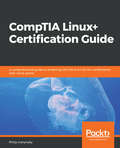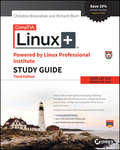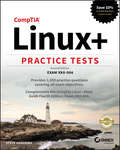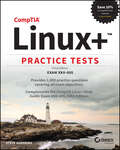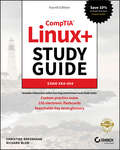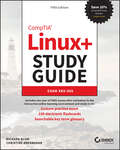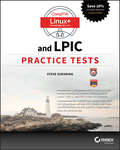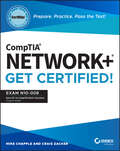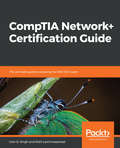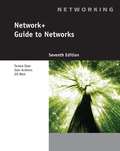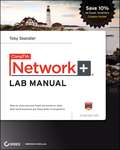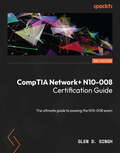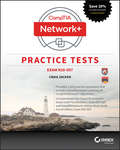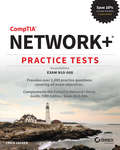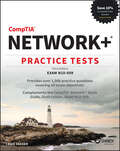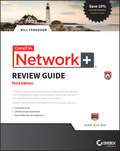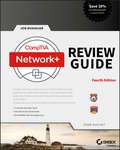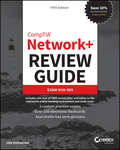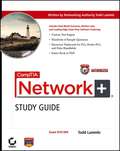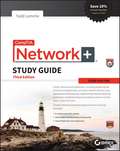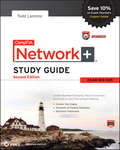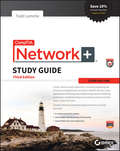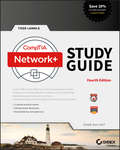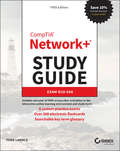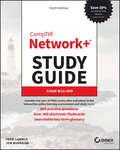- Table View
- List View
CompTIA Linux+ Certification Guide: A comprehensive guide to achieving LX0-103 and LX0-104 certifications with mock exams
by Philip InshanallyMaster the concepts and techniques that will help you gain the LX0-103 and LX0-104 certifications on your first attempt Key FeaturesGet a clear understanding of how to achieve the Linux+ certificationExplore system architecture, shell scripts, data management, and Linux securityWork through practice and mock tests to pass both LX0-103 and LX0-104 examsBook DescriptionLinux+ certification demonstrates technical competency and provides a broad awareness of Linux operating systems. Professionals who have achieved the Linux+ certification exhibit all-important knowledge of installation, operation, administration, and troubleshooting services.The CompTIA Linux+ Certification Guide is an overview of the certification that gives you insights into the system architecture. You’ll understand how to install and uninstall Linux distributions, followed by working with various package managers. Once you’ve grasped all this, you’ll move on to manipulating files and processes at command-line interface (CLI) and creating, monitoring, killing, restarting, and modifying processes.As you progress, you’ll be equipped to work with display managers and learn how to create, modify, and remove user accounts and groups, as well as understand how to automate tasks. The last set of chapters helps you configure dates and set up local and remote system logging. In addition to this, you’ll explore different internet protocols, along with discovering network configuration, security administration, Shell scripting, and SQL management.By the end of this book, you’ll not only have got to grips with all the modules using practice questions and mock exams, but you’ll also be well prepared to pass the LX0-103 and LX0-104 certification exams.What you will learnUnderstand the Linux system architecture Install, upgrade, and manage Linux system packagesConfigure devices and maintain the Linux filesystemManage the Shell environment, write scripts, and manage dataSet user interfaces and desktops in the Linux operating systemAutomate system admin tasks and manage essential system servicesManage SQL server on Linux and log locally and remotely with rsyslogdAdminister network and local securityWho this book is forThe CompTIA Linux+ Certification Guide is for you if you want to gain the CompTIA Linux+ certificate. This guide is also for system administrators and rookie Linux professionals interested in enhancing their Linux and Shell scripting skills. No prior knowledge of Linux is needed, although some understanding of Shell scripting would be helpful.
CompTIA Linux+ Powered by Linux Professional Institute Study Guide
by Richard Blum Christine BresnahanCompTIA Authorized Linux+ prepCompTIA Linux+ Study Guide is your comprehensive study guide for the Linux+ Powered by LPI certification exams. With complete coverage of 100% of the objectives on both exam LX0-103 and exam LX0-104, this study guide provides clear, concise information on all aspects of Linux administration, with a focus on the latest version of the exam. You'll gain the insight of examples drawn from real-world scenarios, with detailed guidance and authoritative coverage of key topics, including GNU and Unix commands, system operation, system administration, system services, security, and more, from a practical perspective that easily translates into on-the-job know-how. You'll also get access to helpful study tools, including bonus practice exams, electronic flashcards, and a searchable glossary of key terms that are important to know for exam day. Linux is viewed by many companies and organizations as an excellent, low-cost, secure alternative to expensive operating systems such as Microsoft Windows. The CompTIA Linux+ Powered by LPI exams test a candidate's understanding and familiarity with the Linux Kernel. Review the basic system architecture, installation, and management Understand commands, devices, and file systems Utilize shells, scripting, and data management techniques Navigate user interfaces, desktops, and essential system services As the Linux server market share continue to grow, so too does the demand for qualified and certified Linux administrators. Certification holders must recertify every five years, but LPI recommends recertifying every two years to stay fully up to date with new technologies and best practices. CompTIA Linux+ Study Guide gives you the advantage of exam day confidence.
CompTIA Linux+ Practice Tests: Exam XK0-004
by Steve SuehringThe best practice test preparation for the foundational CompTIA Linux+ certification exam If you’re preparing for this all-important exam, turn to CompTIA Linux+ Practice Tests. The book covers the 5 objective domains, PLUS one additional 90-question practice exam, for a total of 1,000 practice test questions. Readers will also get one year of FREE access to the online test bank where they can study and work through the questions, reinforcing their skills and knowledge. Study for the CompTIA Linux+ certification with Sybex and get the advantage of exam day confidence. This book covers: Hardware and System Configuration Systems Operation and Maintenance Security Linux Troubleshooting and Diagnostics Automation and Scripting Linux is a UNIX-based operating system originally created by Linus Torvalds with the help of developers around the world. Developed under the GNU General Public License, the source code is free. Because of this, Linux is viewed by many organizations and companies as an excellent, low-cost, secure alternative to expensive OSs, such as Microsoft Windows. The CompTIA Linux+ exam tests a candidate's understanding and familiarity with the Linux Kernel. As the Linux server market share continues to grow, so too does demand for qualified and certified Linux administrators.
CompTIA Linux+ Practice Tests: Exam XK0-005
by Steve SuehringThe best test preparation resource for the CompTIA Linux+ certification exam In the newly updated Third Edition of CompTIA Linux+ Practice Tests: Exam XK0-005, veteran Linux expert, Steve Suehring, delivers an instructive set of practice questions written to get you ready to ace the new XK0-005 test. Providing hundreds of domain-by-domain questions covering system management, security, scripting, containers, automation, and troubleshooting, the book helps you prepare for the exam with confidence and efficiency. You&’ll be able to pinpoint those areas you&’ve mastered and those which require more study, as well as get a feel for the structure of the test itself. The book also offers: Hundreds of practice questions that reinforce your skills and knowledge A great way for practicing and aspiring Linux network and system administrators to improve their on-the-job skills One year of complimentary access after activation to the online Sybex test bank, where you can study and work through hundreds of questionsAn indispensable resource for anyone preparing for the CompTIA Linux+ exam, CompTIA Linux+ Practice Tests: Exam XK0-005, Third Edition, is also a must-have for new and experienced sysadmins and network administrators seeking to identify areas of strength and weakness and improve their grasp of Linux systems.
CompTIA Linux+ Study Guide: Exam XK0-004
by Richard Blum Christine BresnahanThe bestselling study guide completely updated for the NEW CompTIA Linux+ Exam XK0-004 This is your one-stop resource for complete coverage of Exam XK0-004, covering 100% of all exam objectives. You'll prepare for the exam smarter and faster with Sybex thanks to superior content including, assessment tests that check exam readiness, objective map, real-world scenarios, hands-on exercises, key topic exam essentials, and challenging chapter review questions. Linux is a UNIX-based operating system originally created by Linus Torvalds with the help of developers around the world. Developed under the GNU General Public License, the source code is free. Because of this Linux is viewed by many organizations and companies as an excellent, low-cost, secure alternative to expensive OSs, such as Microsoft Windows. The CompTIA Linux+ exam tests a candidate's understanding and familiarity with the Linux Kernel. As the Linux server market share continues to grow, so too does demand for qualified and certified Linux administrators. Building on the popular Sybex Study Guide approach, this book will provide 100% coverage of the NEW Linux+ Exam XK0-004 objectives. The book contains clear and concise information on all Linux administration topic, and includes practical examples and insights drawn from real-world experience. Hardware and System Configuration Systems Operation and Maintenance Security Linux Troubleshooting and Diagnostics Automation and Scripting You’ll also have access to an online test bank, including a bonus practice exam, electronic flashcards, and a searchable PDF of key terms.
CompTIA Linux+ Study Guide: Exam XK0-005 (Sybex Study Guide)
by Richard Blum Christine BresnahanThe best-selling, hands-on roadmap to acing the new Linux+ exam In the newly updated Fifth Edition of CompTIA Linux+ Study Guide: Exam XK0-005, IT industry veterans and tech education gurus Richard Blum and Christine Bresnahan deliver a concise and practical blueprint to success on the CompTIA Linux+ exam and in your first role as a Linux network or system administrator. In the book, you’ll find concrete strategies and proven techniques to master Linux system management, security, scripting, containers, automation, and troubleshooting. Every competency tested on the Linux+ exam is discussed here. You’ll also get: Hands-on Linux advice that ensures you’re job-ready on the first day of your new network or sysadmin role Test-taking tips and tactics that decrease exam anxiety and get you ready for the challenging Linux+ exam Complimentary access to the Sybex learning environment, complete with online test bank, bonus practice exams, electronic flashcards, and a searchable glossary Perfect for practicing network and system admins seeking an in-demand and valuable credential for working with Linux servers and computers, CompTIA Linux+ Study Guide: Exam XK0-005, Fifth Edition, will also earn a place in the libraries of people looking to change careers and start down an exciting new path in tech. And save 10% when you purchase your CompTIA exam voucher with our exclusive WILEY10 coupon code.
CompTIA Linux+ and LPIC Practice Tests: Exams LX0-103/LPIC-1 101-400, LX0-104/LPIC-1 102-400, LPIC-2 201, and LPIC-2 202
by Steve SuehringBoost your Linux+/LPIC readiness with practice tests for all exam domains CompTIA Linux+ and LPIC Practice Tests provide 100% coverage of all exam objectives for both the CompTIA Linux+ exams LX0-103 and LX0-104, and the LPIC exams 101-400, 102-400, and 201and 202, through 1,200+ expertly crafted practice questions. These easy to navigate practice questions cover the Linux+ and LPIC-1 exams, covering all 10 domains. The second part covers the LPIC-2 exam, covering all 13 LPIC-2 domains. An additional two 60-question practice exams per section help you gauge your readiness — and hone your test-taking strategy — well in advance of exam day, giving you the thorough preparation you need to approach the exam with confidence. You will also gain access to the Sybex interactive learning environment where you have access to all questions and can create your own practice tests based on areas further review is needed Master the skills and concepts on the LPIC-1 and the LPIC-2 exams Gauge your understanding with unique practice tests for each exam domain Identify weak points and prioritize your preparation Preview exam day with four 60-question practice exams Practice tests are among the most effective exam preparation strategies. These tests are designed to mimic the Linux+, LPIC-1 and LPIC-2 exams, giving you the practice you need to ensure you are fully prepared. This book can be used alone or with the Sybex study guides and deluxe study guides. Start preparing for your Linux certification today.
CompTIA Network+ CertMike: Exam N10-008 (CertMike Get Certified)
by Craig Zacker Mike ChappleA laser-focused and job-ready blueprint for success on the CompTIA Network+ exam and a running start on your first (or next) job in tech CompTIA Network+ CertMike: Prepare. Practice. Pass the Test! Get Certified! Exam N10-008 delivers a no-nonsense, straight-to-business guide to acing the CompTIA Network+ test on your first attempt. Veteran tech experts and educators Mike Chapple and Craig Zacker walk you through every step you’ll need to take on the N10-008 exam, from networking fundamentals, implementations, and operations to network security and troubleshooting. Ace the test using the proven CertMike approach: Prepare -- CertMike is your personal study coach, guiding you through all the exam objectives and helping you gain an understanding of how they apply to on-the-job tasks! Practice -- Each chapter includes two multiple choice practice questions. Work through the detailed explanations to evaluate each answer option and understand the reason for the best answer! Pass -- On exam day, use the critical knowledge you've learned when you’re ready to take the test. You'll feel ready and confident to pass the exam and earn your certification! The book skips the fluff and gets right to the point of getting you familiar with network basics and on the road to an in-demand certification and a new career as a network technician or admin. You’ll also get complimentary access to additional Sybex online study tools, including a bonus practice exam and audio recordings of the book’s CertMike Exam Essentials. A can’t-miss roadmap to success on the Network+ exam, CompTIA Network+ CertMike: Prepare. Practice. Pass the Test! Get Certified! Exam N10-008 is the job-focused and practical guide you’ve been looking for to help you hone your networking skills.
CompTIA Network+ Certification Guide: The ultimate guide to passing the N10-007 exam
by Glen D. Singh Rishi LatchmepersadThis is a practical certification guide covering all the exam topics in an easy-to-follow manner backed with self-assessment scenarios for better preparation. Key Features A step-by-step guide to give you a clear understanding of the Network+ Certification Learn about network architecture, protocols, security, and network troubleshooting Confidently ace the N10-007 exam with the help of practice tests Book Description CompTIA certified professionals have always had the upper hand in the information technology industry. This book will be your ideal guide to efficiently passing and achieving this certification. Learn from industry experts and implement their practices to resolve complex IT issues. This book revolves around networking concepts where readers will learn topics like network architecture, security, network monitoring, and troubleshooting. This book will not only prepare the readers conceptually but will also help them pass the N10-007 exam. This guide will also provide practice exercise after every chapter where readers can ensure their concepts are clear. By the end of this book, readers will leverage this guide and the included practice questions to boost their confidence in appearing for the actual certificate. What you will learn Explain the purpose of a variety of networking concepts and implement them appropriately Understand physical security and common attacks while securing wired and wireless networks Understand the fundamentals of IPv4 and IPv6 Determine and explain the appropriate cabling, device, and storage technologies Understand network troubleshooting methodology and appropriate tools to support connectivity and performance Use best practices to manage the network, determine policies, and ensure business continuity Who this book is for This book is ideal for readers wanting to pass the CompTIA Network+ certificate. Rookie network engineers and system administrators interested in enhancing their networking skills would also benefit from this book. No Prior knowledge on networking would be needed.
CompTIA Network+ Guide to Networks, Seventh Edition
by Jean Andrews Tamara Dean Jill WestThis book introduces the fundamental building blocks that form a modern network, such as protocols, media, topologies, and hardware and provides in-depth coverage of the most important concepts in contemporary networking, such as TCP/IP, Ethernet, wireless transmission, virtual networks, security, and troubleshooting. Students will have the skills to build a network from scratch and maintain, upgrade, troubleshoot, and manage an existing network and will be well-prepared to pass CompTIA's Network+ N10-006 certification exam.
CompTIA Network+ Lab Manual
by Toby SkandierGain street-smart skills in network administrationThink of the most common and challenging tasks that network administrators face, then read this book and find out how to perform those tasks, step by step. CompTIA Network + Lab Manual provides an inside look into the field of network administration as though you were actually on the job. You'll find a variety of scenarios and potential roadblocks, as well as clearly mapped sections to help you prepare for the CompTIA Network+ Exam N10-005. Learn how to design, implement, configure, maintain, secure, and troubleshoot a network with this street-smart guide.Provides step-by-step instructions for many of the tasks network administrators perform on a day-to-day basis, such as configuring wireless components; placing routers and servers; configuring hubs, switches, and routers; configuring a Windows client; and troubleshooting a networkAddresses the CompTIA Network+ Exam N10-005 objectives and also includes a variety of practice labs, giving you plenty of opportunities for hands-on skill-buildingOrganized by the phases of network administration: designing a network, implementing and configuring it, maintenance and security, and troubleshootingStudy, practice, and review for the new CompTIA Network+ N10-005 Exam, or a networking career, with this practical, thorough lab manual.
CompTIA Network+ N10-008 Certification Guide: The ultimate guide to passing the N10-008 exam, 2nd Edition
by Glen D. SinghBecome a network specialist by developing your skills in network implementation, operations and security while covering all the exam topics for CompTIA Network+ N10-008 certification in an easy-to-follow guide.Purchase of the print or Kindle book includes a free eBook in the PDF format.Key FeaturesA step-by-step guide to gaining a clear understanding of the Network+ certificationLearn about network architecture, protocols, security, and network troubleshootingConfidently ace the N10-008 exam with the help of 200+ practice test questions and answersBook DescriptionThis book helps you to easily understand core networking concepts without the need of prior industry experience or knowledge within this fi eld of study. This updated second edition of the CompTIA Network+ N10-008 Certification Guide begins by introducing you to the core fundamentals of networking technologies and concepts, before progressing to intermediate and advanced topics using a student-centric approach.You'll explore best practices for designing and implementing a resilient and scalable network infrastructure to support modern applications and services. Additionally, you'll learn network security concepts and technologies to effectively secure organizations from cyber attacks and threats. The book also shows you how to efficiently discover and resolve networking issues using common troubleshooting techniques.By the end of this book, you'll have gained sufficient knowledge to efficiently design, implement, and maintain a network infrastructure as a successful network professional within the industry. You'll also have gained knowledge of all the official CompTIA Network+ N10-008 exam objectives, networking technologies, and how to apply your skills in the real world.What you will learnExplore common networking concepts, services, and architectureIdentify common cloud architecture and virtualization conceptsDiscover routing and switching technologiesImplement wireless technologies and solutionsUnderstand network security concepts to mitigate cyber attacksExplore best practices to harden networks from threatsUse best practices to discover and resolve common networking issuesWho this book is forThis book is for students, network administrators, network engineers, NOC engineers, systems administrators, cybersecurity professionals, and enthusiasts. No prior knowledge in networking is required to get started with this book.
CompTIA Network+ Practice Tests: Exam N10-007
by Craig ZackerA smarter, faster review for the CompTIA Network+ exam N10-007 Expertly authored questions provide comprehensive, concise review of 100% of all CompTIA Network+ exam objectives. This certification validates skills equivalent to nine months of practical networking experience; those earning the Network+ certificate will have the skills needed to install, configure, and troubleshoot today's basic networking hardware peripherals and protocols. CompTIA Network+ Practice Tests (Exam N10-007) offers 1200 practice questions with answers and explanations, organized into 5 full-length chapter tests, PLUS 2 practice exams, and a year of FREE access to the online test bank. Coverage includes: Network Architecture; Network Operations; Network Security; Troubleshooting; and Industry Standards, Practices, and Network Theory. It’s the ideal companion to the CompTIA Network+ Study Guide, CompTIA Network+ Review Guide, and CompTIA Network+ Deluxe Study Guide for Exam N10-007! • Covers advances in networking technology • Reflects changes in associated job tasks • Places emphasis on network implementation and support • Includes coverage of cloud and wireless networking topics This book helps you gain the confidence you need for taking the new CompTIA Network+ Exam N10-007. The practice test questions prepare you for test success.
CompTIA Network+ Practice Tests: Exam N10-008
by Craig ZackerAssess and improve your networking skillset with proven Sybex practice tests In the freshly revised Second Edition of CompTIA Network+ Practice Tests Exam N10-008, IT expert and author Craig Zacker delivers a set of accessible and useful practice tests for the updated Network+ Exam N10-008. You’ll prepare for the exam, learn the information you need in an industry interview, and get ready to excel in your first networking role. These practice tests will gauge your skills in deploying wired and wireless devices; understanding network documentation and the purpose of network services; work with datacenter, cloud, and virtual networking concepts; monitor network activity; and more. Further, this book offers: Comprehensive coverage of all five domain areas of the updated Network+ exam, including networking fundamentals, implementations, operations, security, and troubleshooting Practical and efficient preparation for the Network+ exam with hundreds of domain-by-domain questions Access to the Sybex interactive learning environment and online test bank Perfect for anyone preparing for the CompTIA Network+ Exam N10-008, the CompTIA Network+ Practice Tests Exam N10-008 is also an indispensable resource for network administrators seeking to enhance their skillset with new, foundational skills in a certification endorsed by industry leaders around the world.
CompTIA Network+ Practice Tests: Exam N10-009 (Certmike Get Certified Ser.)
by Craig ZackerAssess and improve your networking skillset with proven Sybex practice tests In the freshly revised Third Edition of CompTIA Network+ Practice Tests Exam N10-009, IT expert and author Craig Zacker delivers a set of accessible and useful practice tests for the updated Network+ Exam N10-009. You'll prepare for the exam, learn the information you need in an industry interview, and get ready to excel in your first networking role. These practice tests gauge your skills in deploying wired and wireless devices; understanding network documentation and the purpose of network services; work with datacenter, cloud, and virtual networking concepts; monitor network activity; and more. This book also offers: Comprehensive coverage of all five domain areas of the updated Network+ exam, including network concepts, implementation, operations, security, and troubleshooting Practical and efficient preparation for the Network+ exam with hundreds of domain-by-domain questions Access to the Sybex interactive learning environment and online test bank Perfect for anyone preparing for the CompTIA Network+ Exam N10-009, the CompTIA Network+ Practice Tests Exam N10-009 is also an indispensable resource for network administrators seeking to enhance their skillset with new, foundational skills in a certification endorsed by industry leaders around the world. And save 10% when you purchase your CompTIA exam voucher with our exclusive WILEY10 coupon code.
CompTIA Network+ Review Guide
by Bill FergusonFast, focused review for the latest CompTIA Network+ Exam N10-005CompTIA's Network+ certification is the leading non-vendor networking certification in the world and has become the standard certification for networking professionals. Make sure you're ready for CompTIA's new Network+ certification (exam N10-005) with this new edition of Sybex's CompTIA Network+ Review Guide. This concise guide is efficiently organized by exam objectives and covers all five exam domains. The book also includes 50 chapter review questions, as well as access to two online practice exams, and much more. It's the perfect companion to Sybex's CompTIA Network+ Study Guide, Second Edition or any Network+ study tool.Helps students prepare for the leading non-vendor-specific networking certification, CompTIA Network+This new edition is fully updated for Exam N10-005, the latest revision of the CompTIA Network+ exam Conveniently organized by exam objectives for quick reviewFeatures Exam Essentials in each chapter to help you focus on what you need to know for the examProvides access to practice exams, and other practice toolsReview all Network+ Exam N10-005 exam objectives and reinforce your studies with CompTIA Network+ Review Guide, Second Edition.
CompTIA Network+ Review Guide: Exam N10-007
by Jon BuhagiarEssential last-minute review aid for the updated CompTIA Network+ Exam N10-007 CompTIA Network+ Review Guide Exam N10-007, 4th Edition, is your ideal study companion for preparing for the CompTIA Network+ exam (N10-007). Organized by exam objectives, this is a focused, concise review guide that works hand-in-hand with any learning tool, including the Sybex CompTIA Network+ Study Guide, CompTIA Network+ Deluxe Study Guide, and CompTIA Network+ Practice Tests. The book is broken into 5 parts, each part corresponding to one of the 5 objective domain areas of the Network+ exam: Network Architecture; Network Operations; Network Security; Troubleshooting; and Industry Standards, Practices, and Network Theory. Readers will also be given access to the comprehensive online Sybex test bank, which includes two bonus practice tests, electronic flashcards, and a glossary of terms that you’ll need to know come exam day. CompTIA's Network+ certification covers advances in networking technology, and reflects changes in associated job tasks. The exam places greater emphasis on network implementation and support, and includes expanded coverage of wireless networking topics. This review guide gives you the opportunity to identify your level of knowledge while there's still time to study, and avoid exam-day surprises. Review network architecture and security Understand network operations and troubleshooting Gain insight into industry standards and best practices Get a firmer grasp of network theory fundamentals If you’re looking for a beginning, vendor-neutral networking certification, look no further than CompTIA Network+.
CompTIA Network+ Review Guide: Exam N10-008
by Jon BuhagiarPrep for success on the Network+ N10-008 exam and for your new career in network administration with this must-have resource In the newly updated Fifth Edition of the CompTIA Network+ Review Guide: Exam: N10-008, a leading expert in Network Operations, Jon Buhagiar, delivers a focused and concise handbook for anyone preparing for the new Network+ N10-008 exam or for a career in network administration. This guide is organized into five parts, with each part corresponding to one of the 5 objective domain areas of the Network+ exam: Fundamentals, Implementations, Operations, Security, and Troubleshooting. You’ll handily learn crucial IT skills like designing and implementing functional networks, configuring and managing essential network devices, using switches and routers to segment network traffic, and securing existing networks. This book also allows you to: Quickly and comprehensively prepare for the Network+ N10-008 exam with intuitively organized info and efficient learning strategies Discover the skills and techniques required in an entry-level network administration interview and job Access the Sybex online learning center, with chapter review questions, full-length practice exams, hundreds of electronic flashcards, and a glossary of key terms Perfect as a standalone resource for those seeking to succeed on the CompTIA Network+ N10-008 exam or as a companion to the CompTIA Network+ Study Guide and CompTIA Network+ Deluxe Study Guide, this book is an indispensable reference for anyone preparing for a career in network administration, network analysis, or systems engineering.
CompTIA Network+ Study Guide
by Todd LammleBestselling author Todd Lammle thoroughly covers this first revision of the CompTIA Network+ exam since 2005. Using his one-of-a-kind conversational style, Todd gives you clear and concise information on crucial networking topics through practical examples and insights drawn from his real-world experience. This Study Guide thoroughly covers all exam objectives for the CompTIA Network+ exam (N10-004), including key topics such as network technologies, media and topologies, devices, management, tools, and security. Along with the book you get a CD-ROM featuring a custom test engine with chapter review questions, two practice exams, flashcards, and the book as a searchable PDF.Note: CD-ROM/DVD and other supplementary materials are not included as part of eBook file.For Instructors: Teaching supplements are available for this title.
CompTIA Network+ Study Guide
by Todd LammleAll-star N10-006 prep, fully updated for the new exam The CompTIA Network+ Study Guide is your one-stop comprehensive resource in preparing for exam N10-006. Bestselling author and networking Guru Todd Lammle guides you through 100% of all exam objectives detailing the fundamental concepts you will need to know to prepare for the exam. Coverage includes network technologies, installation and configuration, media and topologies, security, and much more, plus practical examples drawn from real-world situations.
CompTIA Network+ Study Guide Authorized Courseware
by Todd LammleTodd Lammle's CompTIA Network+ Authorized Study Guide for the N10-005 exam!CompTIA's Network+ certification tells the world you have the skills to install, configure, and troubleshoot today's basic networking hardware peripherals and protocols. But first, you have to pass the exam! This detailed CompTIA Authorized study guide by networking guru Todd Lammle has everything you need to prepare for the CompTIA's new Network+Exam N10-005. All exam objectives are covered. He thoroughly explains key topics, offers plenty of practical examples, and draws upon his own invaluable 25+ years of networking experience to help you learn.Prepares you for Exam N10-005, the new CompTIA Network+ Exam.Covers all exam objectives including network technologies, network installation and configuration, network media and topologies, security, and much more.Includes practical examples review questions, as well as access to practice exams and flashcards to reinforce learning. Go to www.sybex.com/go/netplus2e to register and download these tools.Networking guru and expert author Todd Lammle offers invaluable insights and tips drawn from real-world experience.Prepare for the exam and enhance your career with the CompTIA Authorized CompTIA Network+ Study Guide, Second Edition.
CompTIA Network+ Study Guide: Exam N10-006
by Todd LammleCovers 100% of exam objectives, including explaining the functions and applications of various network devices, using appropriate monitoring tools, implementing network hardening techniques, troubleshooting and resolving common wireless issues, and much more...Includes interactive online learning environment and study tools with: + 2 custom practice exams + More than 100 Electronic Flashcards + Searchable key term glossary Your complete guide to preparing for CompTIA Network+ Exam N10-006 The CompTIA Network+ Study Guide, 3rd Edition is your one-stop resource for complete coverage of Exam N10-006. This Sybex Study Guide covers 100% of all exam N10-006 objectives. You'll prepare for the exam smarter and faster with Sybex thanks to superior content including, assessment tests that check exam readiness, objective map, real-world scenarios, hands-on exercises, key topic exam essentials, and challenging chapter review questions. Reinforce what you have learned with the exclusive Sybex online learning environment and test bank, accessible across multiple devices. Get prepared for the CompTIA Network+ exam with Sybex. Coverage of 100% of all exam objectives in this Study Guide means you'll be ready for: Comparing and contrasting the use of networking services and applications Installing and configuring network services/applications Analyzing metrics and reports from monitoring and tracking performance tools Using appropriate resources to support configuration management Comparing and contrasting common network vulnerabilities and threats Installing and configuring a basic firewall Summarizing basic forensic concepts Implementing network troubleshooting methodology Troubleshooting and resolving common copper cable issues Troubleshooting and resolving common network issues Analyzing and determining the correct OSI layer Explaining the basics of network theory and concepts Summarizing safety practices Installing and configuring equipment in the appropriate location using best practices Interactive learning environment Take your exam prep to the next level with Sybex's superior interactive online tools. To access the learning environment, simply visit: http://sybextestbanks.wiley.com, type in your unique PIN and instantly gain access to: Interactive test bank with 2 practice exams. Practice exams help you identify areas where further review is needed. Get more than 90% of the answers correct, and you're ready to take the certification exam. 100 questions total! More than 100 Electronic Flashcards to reinforce learning and provide lastminute prep before the exam Comprehensive glossary in PDF format that gives you instant access to the key terms so you are fully prepared
CompTIA Network+ Study Guide: Exam N10-007
by Todd LammleTodd Lammle's bestselling CompTIA Network+ Study Guide for the N10-007 exam! CompTIA's Network+ certification tells the world you have the skills to install, configure, and troubleshoot today's basic networking hardware peripherals and protocols. First, however, you have to pass the exam! This detailed CompTIA Authorized study guide by networking guru Todd Lammle has everything you need to prepare for the CompTIA Network+ Exam N10-007. Todd covers all exam objectives, explains key topics, offers plenty of practical examples, and draws upon his own invaluable 30 years of networking experience to help you learn. The Study Guide prepares you for Exam N10-007, the new CompTIA Network+ Exam: • Covers all exam objectives including network technologies, network installation and configuration, network media and topologies, security, and much more • Includes practical examples review questions, as well as access to practice exams and flashcards to reinforce learning • Networking guru and expert author Todd Lammle offers valuable insights and tips drawn from real-world experience Plus, receive one year of FREE access to a robust set of online interactive learning tools, including hundreds of sample practice questions, a pre-assessment test, bonus practice exams, and over 100 electronic flashcards. Prepare for the exam and enhance your career—starting now!
CompTIA Network+ Study Guide: Exam N10-008
by Todd LammlePrepare for the Network+ certification and a new career in network installation and administration In the newly revised Fifth Edition of CompTIA Network+ Study Guide Exam N10-008, bestselling author and network expert Todd Lammle delivers thorough coverage of how to install, configure, and troubleshoot today’s basic networking hardware peripherals and protocols. This book will prepare you to succeed on the sought-after CompTIA Network+ certification exam, impress interviewers in the network industry, and excel in your first role as a junior network administrator, support technician, or related position. The accomplished author draws on his 30 years of networking experience to walk you through the ins and outs of the five functional domains covered by the Network+ Exam N10-008: Networking fundamentals, implementations, operations, security, and troubleshooting. You’ll also get: Complete, domain-specific coverage of the updated Network+ Exam N10-008 Preparation to obtain a leading network certification enjoyed by over 350,000 networking professionals Access to a superior set of online study tools, including practice exams, flashcards, and glossary of key terms. Perfect for anyone preparing for the latest version of the CompTIA Network+ Exam N10-008, the Fifth Edition of CompTIA Network+ Study Guide Exam N10-008 is a must-have resource for network administrators seeking to enhance their skillset with foundational skills endorsed by industry and thought leaders from around the world.
CompTIA Network+ Study Guide: Exam N10-009 (Sybex Study Guide)
by Todd Lammle Jon BuhagiarPrepare for the Network+ certification and a new career in network installation and administration In the newly revised Sixth Edition of CompTIA Network+ Study Guide: Exam N10-009, bestselling authors and network experts Todd Lammle and Jon Buhagiar deliver thorough and accurate coverage of how to install, configure, and troubleshoot today's networking hardware peripherals and protocols. This book shows you how to succeed on the in-demand CompTIA Network+ certification exam, impress interviewers in the networking industry, and excel in your first role as a network administrator, support technician, or related position. The accomplished authors draw on their combined 30+ years of networking experience to walk you through the ins and outs of the five functional domains covered by the Network+ Exam: N10-009: Networking concepts, implementation, operations, security, and troubleshooting. You'll also get: Comprehensive, domain-specific coverage of the updated Network+ Exam: N10-009 objectives Preparation for the leading network certification used by over 350,000 networking professionals Access to a superior set of online study tools, including hundreds of practice questions, flashcards, and a glossary of key terms Perfect for anyone preparing for the latest version of the CompTIA Network+ Exam: N10-009, the Sixth Edition of CompTIA Network+ Study Guide: Exam N10-009 is a must-have resource for network admins seeking to enhance their skillset with foundational skills endorsed by industry pros and thought leaders from around the world. And save 10% when you purchase your CompTIA exam voucher with our exclusive WILEY10 coupon code.
